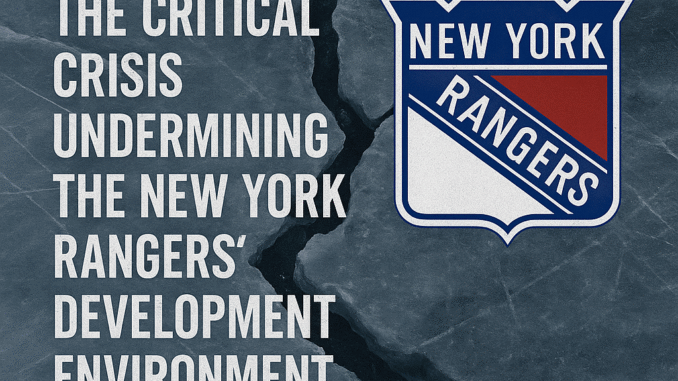
Fractured Ice: The Critical Crisis Undermining the New York Rangers’ Development Environment… read more…
In the high-stakes world of professional hockey, where talent pipelines and organizational culture can define the difference between perennial contenders and chronic underachievers, the New York Rangers now find themselves at a troubling crossroads. Despite boasting a roster of promising young stars and one of the NHL’s most passionate fanbases, the Rangers are currently facing a deep-rooted development crisis that threatens to derail years of potential progress. From a toxic internal culture to failed player development and coaching instability, the team’s structural issues have come to the surface, demanding urgent attention.
A Toxic Culture Behind Closed Doors
In December 2024, a revealing article by Le Journal de Montréal peeled back the curtain on what it described as a “nauseating environment” inside the Rangers organization. Among the most jarring details were mass firings of long-time medical and support staff, including beloved head therapist Jim Ramsay, and an increasingly hostile relationship between management and the broader team environment. The report characterized Madison Square Garden’s upper offices as “paranoid and vindictive,” sparking widespread concern among fans and media alike.
Anecdotes from Reddit and other fan forums only echo the sentiment. One widely shared comment from a self-identified employee described an atmosphere where staff were told they were “not welcome at the training facility” after years of service. Such reports not only shake the morale of those within the organization but also foster a sense of instability that can poison every layer of a team’s performance — especially its approach to player development.
Drafting Stars, Developing Busts
Perhaps the most glaring symptom of the Rangers’ development crisis lies in the mismanagement of their once-promising prospects. Between 2017 and 2020, the team had access to high draft picks and selected players such as Lias Andersson (7th overall, 2017), Kaapo Kakko (2nd overall, 2019), and Alexis Lafrenière (1st overall, 2020). All three were projected to become franchise-altering stars. Instead, they have either underperformed dramatically or struggled to find consistent roles under the current regime.
While the raw talent is undeniable, critics argue that the Rangers’ rigid and outdated development system has failed to adapt to the evolving NHL. Rather than building personalized growth plans, young players were often slotted into roles that prioritized short-term success over long-term development. Players like Kakko and Lafrenière were frequently moved up and down the lineup or benched for extended stretches, stunting their confidence and disrupting rhythm.
In a May 2025 piece for the New York Post, columnist Larry Brooks laid out what he called the “most damning evidence of dysfunction” — the reality that so many young Rangers have failed to make the leap despite being given the spotlight. He questioned whether Chris Drury, the team’s general manager, truly has a vision for nurturing elite talent or if the organization is stuck in a reactive mindset that prioritizes veteran stopgaps over homegrown excellence.
Leadership Void and Coaching Carousel
Organizational dysfunction tends to trickle from the top, and the Rangers’ coaching instability over the past several years is another clear marker of systemic failure. In just five offseasons, the Rangers have cycled through three head coaches. The result is a confused locker room culture where players have had to adapt to new systems, voices, and expectations almost annually.
Former head coach Gerard Gallant, despite leading the team to a strong 2021–22 campaign, was dismissed after reportedly clashing with management over playing style and roster utilization. Peter Laviolette, brought in as a stabilizing force, also failed to deliver a coherent system that supported youth development, leading to his departure after just one season.
This constant turnover has created a leadership vacuum, both on the bench and in the dressing room. Currently, the team remains without a captain — a decision that, while intended to avoid pressure on young stars, also reflects a lack of clear internal hierarchy. There is growing pressure for the team to name a leader like J.T. Miller or Chris Kreider to assume that mantle and provide the voice needed to unify the locker room.
The Way Forward: Fixing the Foundation
In response to mounting criticism, a nine-point plan recently proposed by several analysts suggests sweeping internal changes: naming a captain to establish leadership, redefining physicality as a core identity, and revamping the player development system to prioritize tailored growth strategies.
Chris Drury’s role has come under renewed scrutiny. Once seen as a potential architect of the Rangers’ golden age, Drury now faces criticism for failing to craft a cohesive strategy. There is speculation within NHL circles that if the team underperforms in the upcoming season, ownership could be forced to consider a front-office shakeup.
Outside pressure is building as well. With fans increasingly vocal on social media, and the New York press corps spotlighting every misstep, the Rangers’ room to operate quietly has vanished. Every trade, every press conference, and every call-up will now be seen through the lens of an organization either rebuilding its soul — or losing it entirely.
Conclusion: A Crisis That Cannot Be Ignored
The crisis currently engulfing the New York Rangers is not the result of a single poor season or a string of bad games. It is systemic, cultural, and strategic — a failure of leadership, communication, and vision. What was once one of the NHL’s most respected franchises now faces a credibility challenge not only among fans but within its own walls.
If the Rangers are to reclaim their identity and reestablish themselves as an elite team, the answer won’t lie in blockbuster trades or expensive free-agent signings. It will lie in the hard, sometimes painful work of rebuilding trust, restoring culture, and developing talent the right way.
The clock is ticking. And in a city as unforgiving as New York, second chances are rare — and patience is rarer still.
Leave a Reply